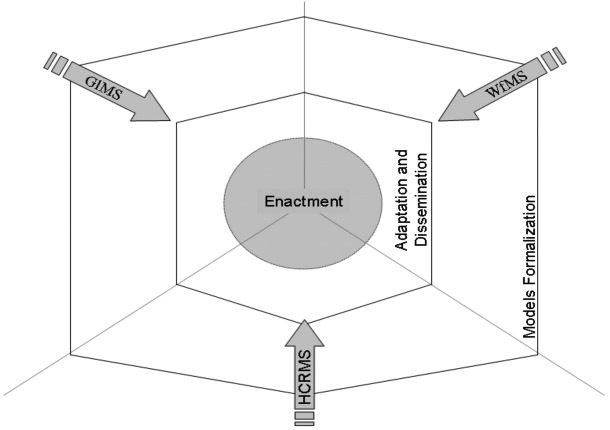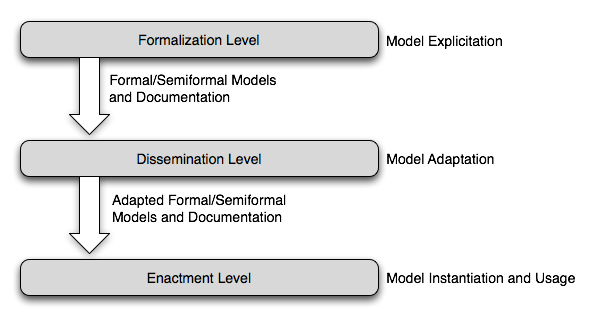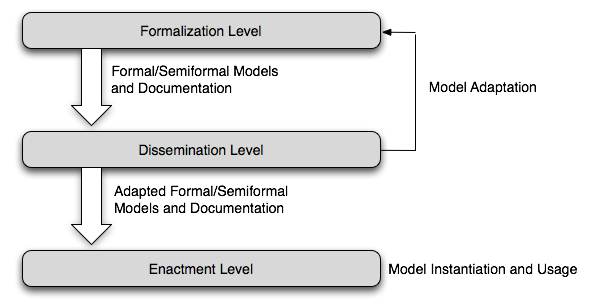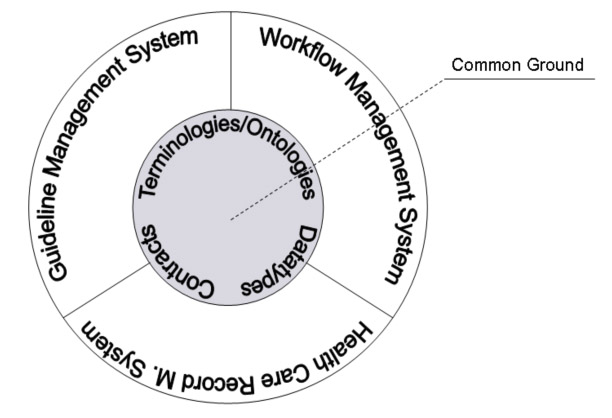The architecture
The Guide Project (TGP) is a distributed environment aiming at the complete management of computerized CPGs life cycle with respect to patient’s and healthcare professionals’ issues. In fact, it is, a knowledge management system allowing formalization of medical, organizational and health care record models (information, processes and knowledge) which will be adapted, combined and distributed in order to implement a full process-based Health Knowledge System (figure 2). In fact, TGP main goal is to support the daily process-oriented examination, diagnosis, treatment, and care of the patient, meanwhile taking care of organizational processes (resources management).

Figure 2 - The process of models definition, adaptation, dissemination and enactment has the same structure for each concern. Each step consists in a well defined knowledge transformation.
For each of the specified concerns we can define a complete process which will take from knowledge models conceptualization/formalization, through adaptation and dissemination, to enactment. It is basically an application of the three fundamentals processes of the knowledge management (see paragraph 1.2). The behavior is similar to the water-fall model, each level transmits knowledge in different forms (formal/semiformal models and documentation) to the subsequent one after an optional transformation process. In the first step, i.e. the formalization, the knowledge is transformed from implicit/tacit to explicit and more important computerizable models. During the second step, i.e. dissemination, explicit knowledge models are adapted and refined according to a more specific setting. Finally in the third phase, i.e. enactment, knowledge models are transformed into interaction between users and systems, users and users and systems and systems.

Figure 3 - The Guide project knowledge models water-fall. Each step consist in a specific knowledge transformation.
The knowledge flow is mainly one-way but it is possible to obtain model adaptation feedback from the dissemination level to the formalization one.

Figure 4 - The Guide project knowledge models water-fall with a feed-back between the dissemination level and the formalization level. This is a powerful model for fostering knowledge models evaluation.
Such feedback is a powerful method for:
- increasing the knowledge exchange between different levels;
- avoiding that different HCOs make the same changes independently;
- managing the process of knowledge models updating;
- evaluating the impact of such knowledge bases on the different HCOs (quality of adaptation are often a measure of HCOs efficiency).
Let me explain the three different levels in detail:
formalization: it represents the level in which the different kinds of knowledge involved in the health care process are defined in form of computerizable models. It corresponds to the step defined by Davenport and Prusak [1.2] as knowledge codification. Formalization can be carried out by different organizations that sell or freely publish computerized models together with traditional electronic and textual documentation. Regarding the medical concern, the formalization is not limited to the Guide Model (defining the health care path) that will be explained later on, but it includes related ontologies (for instance drugs interaction ontologies) and terminologies (in the case adopted official terminologies are not enough to cover all the needs or in the case organizations decide to develop internal terminologies only). Moreover, CPGs may include decision-analytic tools, like decision trees and probabilistic networks, mainly when patient’s preferences and trade-offs are to be taken into account. As an example, 2.11 describes an influence diagram in a breast cancer context, aimed at sharing the decision on surgical options between the physician and the patient) .All this models together will represent the medical knowledge base for a particular health care path.
dissemination: it is a middle layer level that allows to customize and share the general purpose knowledge models. It is in fact a local adaptation [2.26]. In general the dissemination and adaptation of medical knowledge bases is quite common as normally the CPGs are not developed for a particular HCO. For organizational issues the dissemination is harder as it is strongly necessary to model the specific HCO. However, we strongly believe it is possible to define a meta-organization model and to formalize pieces of CPGs-related workflow based on such model in order to make the whole workflow definition faster.
enactment: it is the final level in which the models are used in clinical practice. The adaptation performed in the above level and usability are the key factors for reaching an effective usage of the system in a given HCO.
The above specified levels, represented in Guide by macro-components, can be organized in a potentially infinite number of configurations aiming at the complete management of the computerized CPGs life cycle. Figure 5 shows a complex example in which formal/semi-formal models are defined by different organizations and are disseminated at a national level (Italian level in this case). To be trusty, these models should be certified by an health authority or scientific organization. Each Italian Region can access the models and the documentation in order to perform new adaptations and then to distribute the modified resources to the HCOs. At the local level, healthcare organizations (HCOs) may decide to adopt one of such CPGs. Site specifications may be performed by individual HCOs before putting CPGs at work in the clinical practice through the enactment level.

Figure 5 - A possible configuration of the three Guide macro-components. This has been defined to deal with the Italian national health service.



